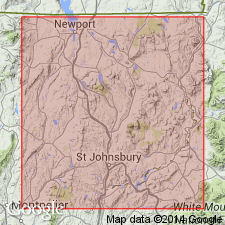
- Usage in publication:
-
- Montpelier slate
- Modifications:
-
- Original reference
- Dominant lithology:
-
- Slate
- AAPG geologic province:
-
- New England province
Summary:
Pg. 95. The terms Montpelier slate, Northfield slate, and Montpelier and Northfield slate have been used interchangeably and indiscriminately in reports on geology of Vermont. If there has been any discrimination whatever, "Northfleid slate" has been used more in a commercial sense than in the designation of a geological formation. I would propose, therefore, the single term Montpelier slate for the terrane that has been formerly discussed under these different names. The name Montpelier is here applied for first time in a purely geological sense to the belt of slate that fianks the pre-Cambrian schist to east of Green Mountain axis, lying conformably upon and often interstratified with Waits River limestone. It is a highly metamorphic rock derived from beds of plastic clay. [On p. 115 he states that USGS has adopted Memphremagog slate, instead of Montpelier slate, preoccupied. Pl. 18 of 11th Rept. Vermont State Geol., 1918, maps this slate as extending from Montpelier to Northfield.]
Source: US geologic names lexicon (USGS Bull. 896, p. 1412).
For more information, please contact Nancy Stamm, Geologic Names Committee Secretary.
Asterisk (*) indicates published by U.S. Geological Survey authors.
"No current usage" (†) implies that a name has been abandoned or has fallen into disuse. Former usage and, if known, replacement name given in parentheses ( ).
Slash (/) indicates name conflicts with nomenclatural guidelines (CSN, 1933; ACSN, 1961, 1970; NACSN, 1983, 2005, 2021). May be explained within brackets ([ ]).

